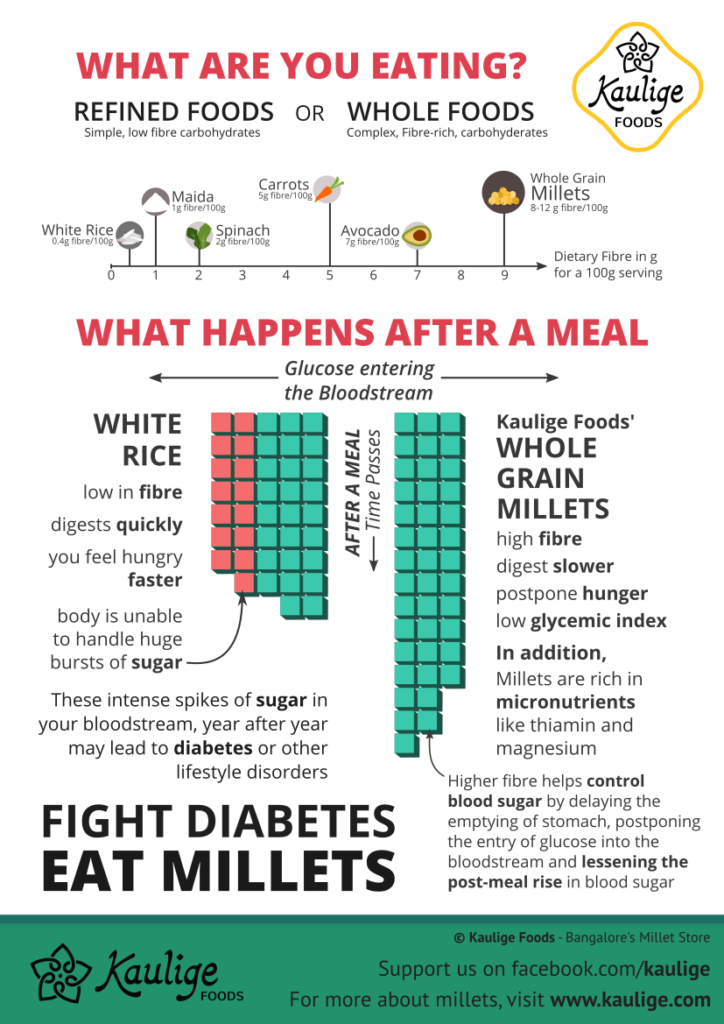No products in the cart.
The following is a transcript of an Interview with Dr Adithya Pradyumna, an expert in public health.
“Millets are good food for diabetics” I have been hearing this from many people, both first hand and second. I knew that Millets are good for us, because of many reasons – nutritional, socio-economical and environmental. But I had no idea about diabetes – why it works the way it works and how it can be prevented or fought against. To understand the causes of diabetes and its relationship with the food we eat, I caught up with Dr. Adithya Pradyumna, a doctor keenly interested in food systems and public health.
Me: Hi Adithya, thanks for agreeing to answer my questions. So I’ll start with this: what is the root cause of diabetes
Ad: Thatís a hard question to answer. From a bio-medical perspective, there are several risk factors for diabetes. These are classified as non-modifiable and modifiable. The non-modifiable factors are related to age and genetics, whereas the modifiable factors include diet, physical activity, lifestyle and other environmental stressors.
Me: How strongly do the genetic predisposition and other non-modifiable factor affect us? Is it even worth it for people to try to prevent diabetes through controlling the modifiable factors?
Ad: Definitely! The Genetic predisposition is associated with both juveline (Type 1) and Adult onset (Type 2) diabetes. But, the risk of diabetes definitely increases if people are living lifestyles which are adverse. Meaning that if people are doing the right kind of physical activity and eating the right kind of food, even though they have a genetic predisposition to diabetes, the risk is much lesser. With the right lifestyle, the occurrence of diabetes can either be prevented or at least delayed – and both of these are worth aspiring to.
Me: Very interesting! What is the right physical activity, you would say, one has to do to decrease the risk of diabetes?
Ad: Researchers have associated diabetes with the lifestyles which people live, on average, in cities. For example, even children sitting in front of the TV instead of playing outdoors, that increases the risk of obesity and diabetes later on. But for adults, it is related to work which primarily involves them sitting for many hours a day, rather than moving around. So, when we talk about physical activity, we cannot, unfortunately, change the way people work. Lets say they are working as software engineers, they cannot run around and work. So, what they have to do is keep aside some time, every week, for doing physical activity; maybe jogging, cycling, walking or swimming or something else.
Ad: There are many, multiple versions of what is the best thing to do. But, keeping aside atleast three half-hours in one week for physical activity is a minimum. Of course, those who are over 65 years of age shouldnít overdo it.
On food
Me: Now about the food, what is the right kind of food which people need to be eating to tilt things in their favour?
Ad: This is a slightly more complicated question to answer. But there are some general principles to follow; one is that a person should eat just as much as needed, not more. There is a tendency nowadays for people to eat more and do less physical activity. So, overeating and eating till one is completely full, that kind of thing should be avoided. Try and control how much you eat.
A: Another principle is regarding the quality of food. There is a classification of food based on glycemic index. Some of the food has been classified as being high in glycemic index. Those kinds of food should be avoided as much as possible. Some foods have a low glycemic index and those foods are preferable to be consumed for diabetes and prevention of diabetes. Whole grains, such as millet, whole grain wheat, pulses, nuts, most fruits and vegetable fall under the list of low glycemic index. White rice, potatoes, watermelon and processed food, such as chocolates, chips, etc fall under the moderate or high glycemic index classification respectively.
On Glycemic Index and Diabetes
Me: How do we know the glycemic index of the food we eat?
Ad: Glycemic Index specifically deals with glucose. It is a measure of what is the level of blood glucose after eating a particular food. Actually, after eating any meal, the blood glucose level increases. This is because digestion and absorption of glucose starts happening. Based on the change of blood sugar for two hours after eating a particular food, the glycemic index is determined. This has been done for various kinds of food and is described in this chart.
Ad: One of the mechanisms of diabetes is that insulin is not secreted properly. Insulin is the hormone released by the pancreas which is involved in managing the glucose in our body. So the problem with food with high glycemic index is that it puts a lot of load on the pancreas, which over a period of time is not able to manage. This is why foods with low glycemic index are preferable.
Me: Why does this manifest itself after so many years? People eat white rice and sweets all their life and diet is a problem, why do people get diabetes after so late in life.
Ad: Age is one of the non-modifiable risk factors of diabetes. With increasing age, the ability of the body to deal with and for organs to respond to stressful stimuli reduces. So the mechanism for these kind of chronic diseases is that the effect of risk factors add up over many years. The cells in the pancreas slowly produce less and less insulin. Also, the cells in the body also respond less and less to insulin due to changes in the insulin receptors, and thereby blood sugar increases.


